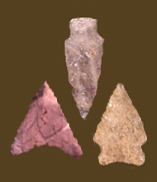
|
MORROW MOUNTAIN
Chronology The Morrow Mountain point dates to the Middle Archaic period. Radiocarbon dates range from 5045 +/- 245 BC (approximately 5850 BC in calendar years) at the Icehouse Bottom site in Tennessee to 4030 +/- 200 BC ( roughly 4850 BC calendar) at Russell Cave in Alabama (Chapman 1976). McAvoy and McAvoy (1997) obtained a radiocarbon date of 6700 +/- 130 BP (roughly 5650 BC) for the Morrow Mountain I point at the Cactus Hill site in Virginia, and a date of 6470 +/- 90 BP (5450 BC) for the Morrow Mountain II point at the Slade site in Virginia. Based on known dates for the two Morrow Mountain varieties and the earlier Stanly point, they suggest a time span of 7100 to 6700 BP (6000-5650 BC) for Morrow Mountain I, and 6800 to 6200 BP (5750-5250 BC) for Morrow Mountain II, although others suggest the data is too limited to fully sort out the chronological relationship between the two varieties (Justice 1987). Excavations at a number of sites have shown that the Morrow Mountain is younger than the Stanly and older than the Guilford and Savannah River points (Justice 1987). Description Blade -- Morrow Mountain I: The blade is usually broad and triangular, with a flat to oval cross section. Sides are most commonly slightly excurvate, although some examples have straight or incurvate sides. Faint and irregular side serrations are characteristic. The blade is widest at the shoulder. Blade -- Morrow Mountain II: The blade is long and narrow, with straight or slightly excurvate sides, which sometimes curve outward at the shoulder. The relatively short blades on some examples appear to be the result of having been re-sharpened. Haft Element: The stem is contracting and the base is pointed. There is a more definite break, or angle, at the shoulder of the Morrow Mountain II than on the Morrow Mountain I, and the stem of the former is longer than on the latter. Light grinding occasionally occurs on the stem and shoulder of the Morrow Mountain I. Size -- Morrow Mountain I: Length ranges from 30 to 70 mm, with an average of 45 mm. Width ranges from 22 to 45 mm, with an average of 30 mm. Thickness ranges from 3 to 6 mm. Size -- Morrow Mountain II: Length ranges from 30 to 80 mm, with an average of 60 mm. Width ranges from 18 to 30 mm, with an average of 20 mm. Thickness ranges from 6 to 10 mm. Technique of manufacture: The larger points appear to have been created using direct percussion and, in general, were crudely fashioned. Smaller points, which are very symmetrical in form, were all finished by pressure flaking. Material: In a sample of 46 Morrow Mountain I points from the lower Patuxent drainage, Steponaitis (1980) reported that 57% were rhyolite and 25% slate, followed by chert, quartz, and quartzite at 6% each. The 31 Morrow Mountain II points in the same area were 65% rhyolite and 35% quartz. In the area surrounding Zekiah Swamp on the lower Potomac, Wanser (1982) found that 45% of 213 Morrow Mountain I points were rhyolite, with 28% quartzite, 23% quartz, and small amounts of argillite, chert, jasper, and other materials. The 235 Morrow Mountain II points in the same area were 49% rhyolite, 27% quartz, 20% quartzite, 2% chert, and smaller amounts of jasper, argillite, and other materials. In the Monocacy River drainage, 66% of 29 Morrow Mountain I points were rhyolite and 34% were quartzite, while all 10 Morrow Mountain II points were rhyolite (Kavanagh 1982). A majority of Morrow Mountain points in the Hagerstown Valley are rhyolite, with smaller numbers of chert and quartz (Stewart 1980). Quartzite Morrow Mountain points predominate in the middle Potomac River Valley, but rhyolite was also used (Hranicky 2002). Heat treatment has been noted on chert and quartzite Morrow Mountain I specimens from the Nottoway River in Virginia (McAvoy and McAvoy 1997). Discussion Defined in Literature Other Names Used References |
![]()
Search by Shape:
(See Projectile Point Typology) |

|
Thank you for visiting our website. If you have any
questions, comments, Copyright © 2002 by |

|

 Defining Attributes
Defining Attributes